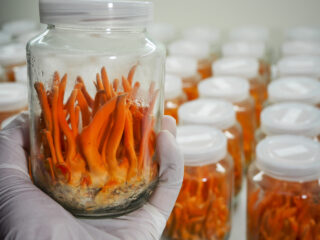Whether starting from a spore or pre-inoculated kit, cleanliness will be a significant factor in the success of your first grow. Mushrooms love a nutrient-rich grow substrate to spread their mycelial “roots” and absorb the nutrients around them. Like mushrooms, mould and bacteria also love nutrient-rich substrates and will almost always out-compete the fungus you are trying to grow. Ensuring you have a clean substrate is integral for the success of your first grow, but this article will focus on the importance of giving the mushrooms the best environment possible, and that starts with where we do our lab work.

Small Spaces And Cleanliness
When I was an amateur grower starting to get my hands on the tools and inoculating my grow substrates, my 4’x8’ bathroom quickly became my “clean” room. A small space in your home with little to no foot traffic will be the best place to get your at-home mycology work done because it will be the most accessible place to keep clean. And remember, we do not need to take over a room in your home permanently; this is only necessary when doing the clean work portion of mushroom cultivation.
The smaller the room, the better. You want to have the space shining from floor to ceiling, and less space means less time cleaning. Depending on your budget, the most common cleaners are Lysol sprays or bleach. When working with any cleaner in a small, sealed environment, it is vital to wear the appropriate attire to keep yourself safe; I recommend gloves, glasses, and a face mask.
Now that we have our space dialled in, we need to bring in our tools and supplies. As you clean or bring items in, it is essential to wipe them all down with a 70% Isopropyl alcohol solution and allow it to evaporate completely before using them.
Personal Hygiene
After you have identified a place in your home, cleaned it from top to bottom, and have all your tools and supplies, it is time to think about the most significant vector of contamination: you! Humans are walking vessels for moulds and bacteria to latch onto, whether it be on your clothes, hair, or even the spit particles that leave our mouths as we talk. No matter how much work and preparation you put into cleaning your environment, you must remember to ensure you are as clean as possible. Before doing at-home lab work, I recommend you shower, dawn a fresh set of clothing, tie up your hair (if applicable), and remove any jewellery before we step into our homemade lab.

Once we set foot into the lab, putting the appropriate PPE on is essential. Basic PPE is a set of disposable gloves and a surgical mask. The gloves will help prevent bacteria or dirt trapped in your fingernails from dislodging while working, and the surgical mask will prevent spit particles from landing on your tools or sterilised substrates.
A Winning Workflow
Proper workflow is the next step to consider when growing mushrooms. Doing all the work in an orderly fashion, moving from the left to the right, will prevent us from reaching back over the top of something that can be contaminated. For example, suppose I plan to spawn bulk substrate in a bag. In that case, I will set up my scissors, isopropyl alcohol, and paper towel on the far left, followed by my bag of spawn, a bag of the substrate, and lastly, my bag sealer on the furthest to the right side of my workbench. This will allow me to use the clean scissors to slice open the two bags, transfer the contents of one bag into the other, and seal the bag with a bag sealer – all without having to reach back over to grab a tool and potentially contaminate a vulnerable open bag of the substrate.
Take Five
Setting yourself up for success in the lab is time well-spent, as five minutes of prep work can save you two weeks of colonising a substrate only to realise it has been contaminated the entire time. Being intentional with your actions and having a proper game plan will bring you success in all of your myco-endevours.
Mushroom Cultivation lays a solid foundation for aspiring mushroom cultivators. This informative piece provides essential insights into creating the optimal environment, choosing the right substrates, and mastering cultivation techniques. Whether you’re a beginner or seeking to enhance your existing skills, this article sets the stage for success in the fascinating world of mushroom cultivation.